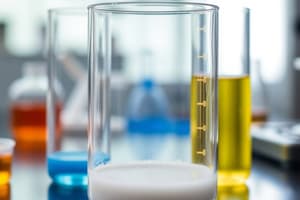Podcast
Questions and Answers
What is the pH range considered physiological for cells?
What is the pH range considered physiological for cells?
- 5.0 to 6.5
- 7.5 to 8.0
- 8.1 to 9.0
- 6.8 to 7.4 (correct)
The pH is calculated as the logarithm of the hydrogen ion concentration.
The pH is calculated as the logarithm of the hydrogen ion concentration.
False (B)
What role do weak acids and their conjugate bases play in cells?
What role do weak acids and their conjugate bases play in cells?
They maintain the regulated pH of cells.
A very weak acid, like water, has a low dissociation constant and cannot neutralize added acids or bases. Its [H+] concentration is _____.
A very weak acid, like water, has a low dissociation constant and cannot neutralize added acids or bases. Its [H+] concentration is _____.
Match the following components to their functions:
Match the following components to their functions:
What is the acid dissociation constant (Ka) for acetic acid?
What is the acid dissociation constant (Ka) for acetic acid?
The human body's physiological pH ranges from 7.4 to 8.0.
The human body's physiological pH ranges from 7.4 to 8.0.
What is the pH of a solution if the pOH is calculated to be 10.0?
What is the pH of a solution if the pOH is calculated to be 10.0?
Buffers are important in biochemical systems to prevent damage caused by an increase in _____ or _____ production.
Buffers are important in biochemical systems to prevent damage caused by an increase in _____ or _____ production.
Match the following chemical concepts with their descriptions:
Match the following chemical concepts with their descriptions:
Flashcards are hidden until you start studying
Study Notes
pH and Buffers
- Protons (H+) are released when cellular components dissolve in water, creating weak acids which equilibrate with their conjugate bases, forming cellular buffer systems.
- Buffers maintain H+ ion concentration, preventing drastic changes in pH, essential for cellular function.
- Human cells produce H+ ions equivalent to 2 L of HCl in 24 hours during metabolism; physiological pH ranges from 6.8 to 7.4.
- Water, a very weak acid, has a low ion product constant (Kw) and cannot neutralize significant acid/base additions.
The pH Scale
- pH is the negative logarithm of H+ ion concentration; a typical biological pH around 7 corresponds to H+ concentration of 10^-7 M.
- Blood plasma typically has a pH of 7.4, reflecting precise H+ management in the body.
Weak Electrolytes
- Weak electrolytes partially dissociate in water; acetic acid (CH3COOH) has an acid dissociation constant (Ka) of 1.74 x 10^-5 M.
- Buffer systems comprise weak acids and their conjugate bases; they are crucial in stabilizing pH amidst metabolic reactions.
Buffering Capacity
- Buffer capacity indicates how much H3O+ or OH- a buffer can maintain without significant pH change, optimal within ±1 pH unit of the pKa of the weak acid.
- Example: Acetic acid (pKa = 4.75) works effectively between pH 3.75 and 5.75.
Henderson-Hasselbalch Equation
- Describes the relationship between pH, pKa, and concentrations of weak acid (HA) and its conjugate base (A-), facilitating buffer calculations.
- pH = pKa + log([A-]/[HA]); applies when concentrations differ.
Practical Applications
- For lactic acid, given concentrations of free acid (0.010 M) and lactate (0.087 M), with pH = 4.80, the calculated pKa is approximately 4.85.
- To determine pH of solutions:
- pOH + pH = 14.
- Calculate H+ concentration when pOH is known using H+ = 10^(-pH).
Example Calculations
- To compute pH from [OH-] = 0.040 M, calculate pOH, then subtract from 14.
- For HCl at 5.0 x 10^-4 M, the pH is determined by pH = -log([H+]) resulting in a pH of approximately 3.30.
Buffers in Biochemistry
- Buffers consist of weak acids and their conjugate bases, helping resist pH changes from acid/base addition.
- Biological buffers include amino acids; these compounds serve as both proton donors and acceptors.
Conclusion on pH Regulation
- Blood's pH range (7.35-7.45) is vital; deviations beyond 0.10 pH units can lead to health issues. Buffers are essential for maintaining this balance and ensuring metabolic integrity.
Studying That Suits You
Use AI to generate personalized quizzes and flashcards to suit your learning preferences.




